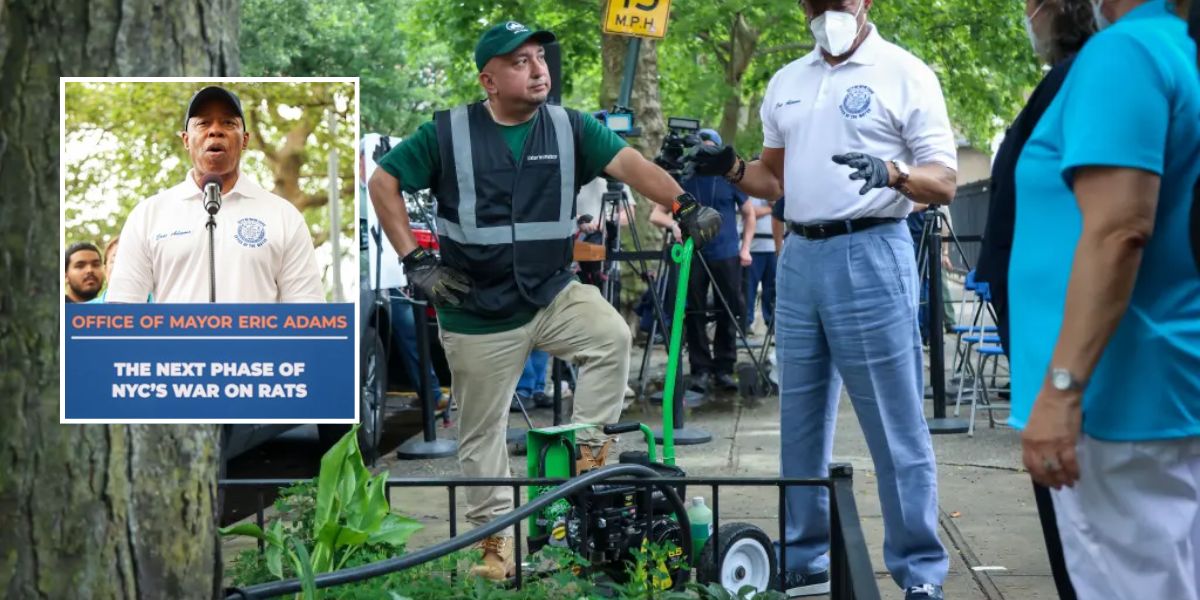They are on a mission to put an end to the vermin crisis that the city is experiencing.
It has been announced that the Adams administration will be releasing a rat killing squad that will cost $877,000 in order to locate the rodents, gas them to death with carbon monoxide, and bury them in and around the 600,000 tree beds that are located in the Big Apple.
During a press conference held on Sunday, officials announced that the Street Tree Bed Rat Mitigation program will involve the utilization of a specialized team consisting of twelve exterminators, park workers, and other individuals who will be responsible for inspecting tree beds and deploying carbon monoxide inside rat burrows.
This is the location where “rodent squatters” will meet their end, with their tunnels being transformed into graves.
“By cleaning up trash and hiring a team of experts to clear out burrows while caring for our trees, we are reclaiming public space, fighting rats, and improving quality of life for all New Yorkers,” Mayor Eric Adams stated. “Our administration continues to build on the work we are doing to end the dominance of trash and rats on our streets.”
According to Adams, the gassing procedure takes roughly three minutes, has a 95% kill rate for seven days, and doesn’t require a license to operate the right equipment.
According to officials, no people nor non-rats are at risk from the gas, and the loud machinery that will be used to release the carbon monoxide will be at least ten feet from the base of any buildings in the area.
The “historically exploited” street tree beds that vermin use as breeding grounds are expected to be eliminated by the most recent campaign in the war on rats, which also includes containerizing 70% of the city’s street waste and even a rat birth control program, according to officials.

Mark Abbott, a resident of Prospect Heights and a member of the Sterling Place Committee on Rat Mitigation (SCRAM), stated during the press conference at Stroud Playground, “As a lifelong New Yorker, my main concern was always the tree beds.”
“At night, [rats] would come out and they would cross into people’s yards – you were afraid to walk down the streets at night because you never knew when one of these things would jump out and decide to scurry across your feet or bring their babies with them,” he stated. “I am so happy to see that this is actually happening.”
Rats meeting their maker, however, is not to everyone’s taste.
Read Also: Texas Gov. Weighs THC Bill That Could Devastate State’s Hemp Industry
According to John Di Leonardo, executive director of Humane Long Island, an animal welfare group, the rats will die a “slow and painful death” from the poison.
Leonardo told that lethal tactics are ineffective because “the resultant spike in the food supply causes accelerated breeding among survivors.”
“There will always be rats in New York City, and a walk through any part of the city shows plenty of food and trash on the sidewalk and streets,” Di Leonardo continued. “If that’s taken care of, the rat population will decrease naturally. Carbon monoxide kills people and pets every day, never intentionally – using it in city parks and streets is both cruel and reckless.”
According to Parks sources, the city’s kill team will begin “immediately” and respond to 311 reports and referrals from the health department, including the 2,300 reports of rats related to street tree beds that were received last year.
Calls to “rat mitigation zones” in Bedford-Stuyvesant/Bushwick, Harlem, Bronx Grand Concourse, and East Village/Chinatown are anticipated to be disproportionately high, according to the team.
311 rodent sighting complaints have down over the past six months compared to the same period last year, with sightings down 22% last month and 17% so far this month, according to City Hall, which mostly attributes the success to changes in garbage containerization regulations.
“For too long, rats in street tree beds have gone unaddressed — undermining the hard work of both city agencies and local communities,” NYC Parks Commissioner Rodriguez-Rosa stated.
“With this new investment, we’re closing that gap. By combining science-based, non-toxic approaches with dedicated staff, we’re protecting our trees, our neighborhoods, and our quality of life.”



